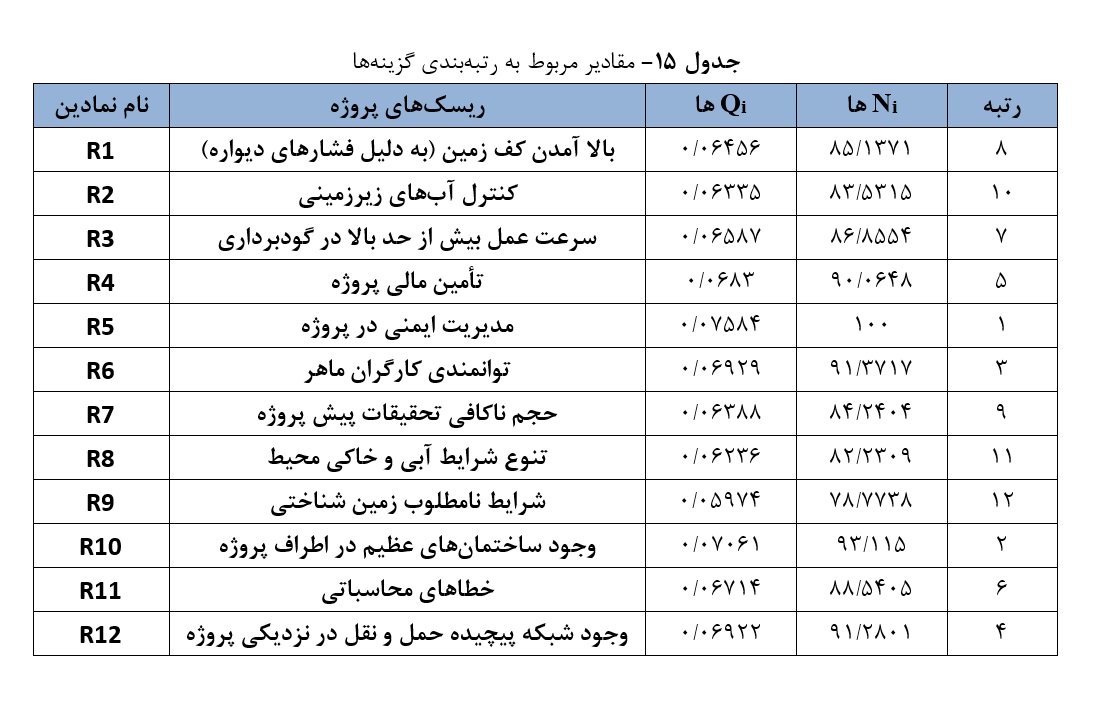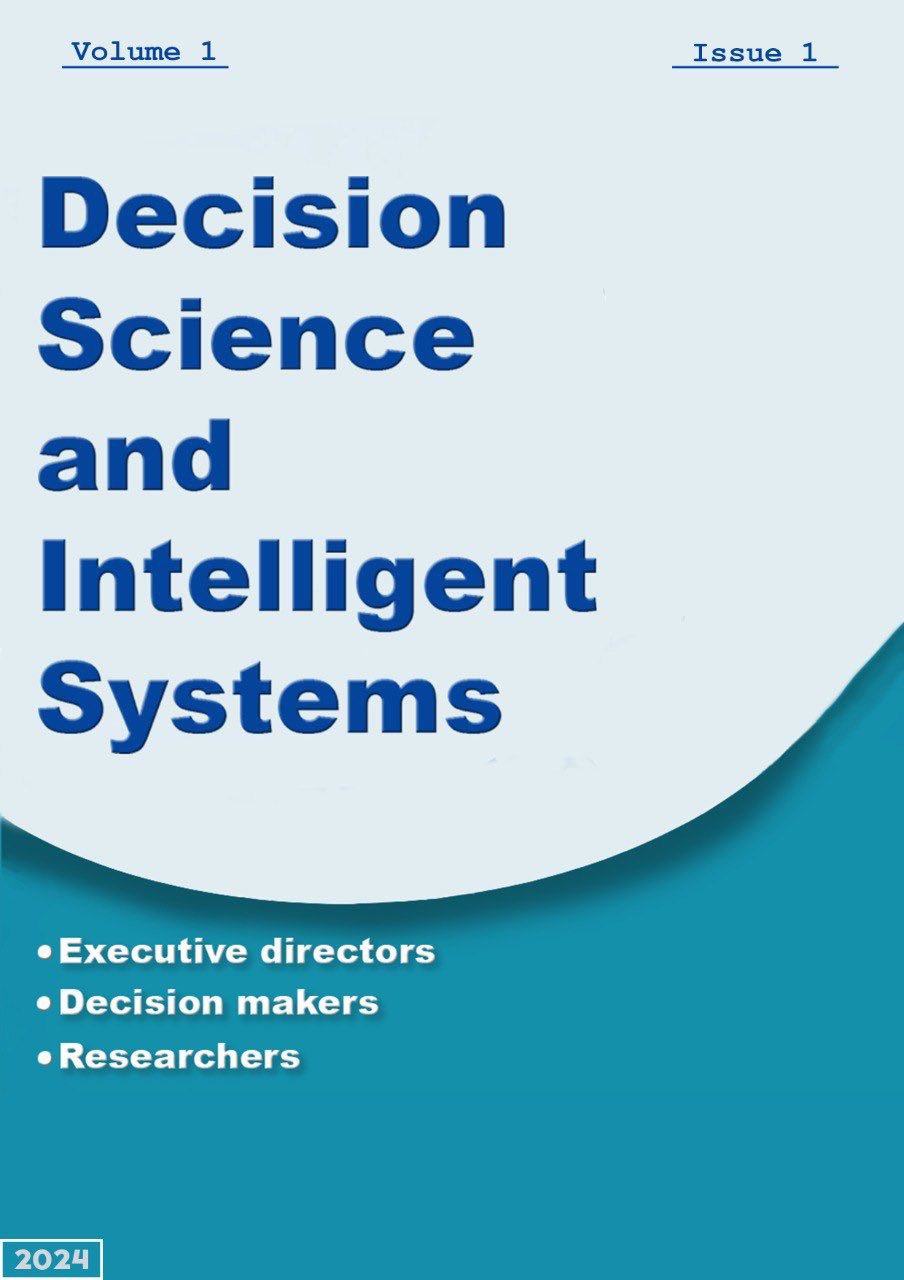Risk Assessment of Deep Excavation in Construction Projects Using a Combined SWARA-COPRAS Approach in a Fuzzy Environment
Keywords:
Deep excavation, construction projects, fuzzy SWARA, fuzzy COPRAS, risk managementAbstract
Nowadays, with the expansion of urban life across the world, the development of construction activities in various urban sectors—ranging from high-rise building projects to the expansion of subway lines—has become highly tangible and, indeed, inevitable. This study was conducted to assess the risks associated with deep excavation in construction projects. In this study, a combined SWARA and COPRAS approach within a Fuzzy logic environment was used to identify risk assessment indicators and to rank the risks associated with the project. The research setting was the deep excavation project of Atieh Gharb Hospital in Tehran, and the required data were collected from experts involved in this project during the excavation phase. Based on the analysis of the study data in its two distinct stages, it was first determined that 11 risk assessment indicators constitute the most important indicators for measuring the risks of deep excavation activities. Among these indicators, risk analysis capability, the degree of risk uniqueness, and the level of project vulnerability to risk were identified as the most critical indicators for assessing the risks of deep excavation projects. Moreover, based on the second stage of the analysis, it was found that the deep excavation project of Atieh Gharb Hospital involves 12 key and major risks. The fuzzy COPRAS approach revealed that among these risks, three key risks were identified as safety management in the project, the presence of massive surrounding buildings, and the availability of skilled workers. Following these, three other important factors—namely the presence of a complex transportation network near the project, project financing, and potential computational errors—were also identified as other significant risks in this project. Finally, recommendations and strategies were provided, based on expert opinions and existing standards, to reduce the risks of similar future deep excavation projects.
References
Akintoye, A. S., & MacLeod, M. J. (1997). Risk analysis and management in construction. International Journal of Project Management, 15(1), 31–38.
Alizadeh Derakhshi, A., & Ardalan Feili, A. (2018). Risk management in urban excavation. In Proceedings of the First International Congress on the Construction Industry with a Focus on New Technologies in the Construction Industry (Tabriz, Iran). East Azerbaijan Young Engineers Association.
Asadi, M. R., Zoghi, H., & Habibi, M. (2017). Identification and ranking of high-rise building project risks using the FMEA approach in Tehran. In Proceedings of the Second National Conference on Applied Research in Civil Engineering (Structural Engineering and Construction Management). Sharif University of Technology.
Chapman, C., & Ward, S. (2003). Project risk management: Processes, techniques and insights. John Wiley & Sons.
Chatterjee, K., Zavadskas, E., Tamošaitienė, J., Adhikary, K., & Kar, S. (2018). A hybrid MCDM technique for risk management in construction projects. Symmetry, 10(2), 46.
Emamgholizadeh, S., & Hosseini, S. A. (2020). Identification and ranking of safety risks in construction projects using combined FMEA and fuzzy TOPSIS approach. Occupational Medicine, 12(1), 13–23. https://sid.ir/paper/959094/fa
English Sources
Fadaei, F., Ajdari Moghadam, M., & Shahreki, M. R. (2022). Risk assessment of dam construction projects using the PROMETHEE and GIAIA methods. Journal of Structural and Construction Engineering, 9(8), 117–137. https://doi.org/10.22065/jsce.2022.299099.2526
Fazli, M., Afshari, A. J., & Hajiaghaei-Keshteli, M. (2018, May). Identification and ranking of risks in green building projects using the hybrid SWARA-COPRAS method. In Proceedings of the International Conference of Iranian Operations Research Society (pp. 2–4). Kermanshah, Iran.
General Directorate of Engineering Services of the Tehran Province Construction Engineering Organization. (n.d.). General guide for supervising engineers: Familiarity with operational steps in effective project supervision (pp. 5–6).
Hatefi, S. M., & Tamošaitienė, J. (2019). An integrated fuzzy DEMATEL-fuzzy ANP model for evaluating construction projects by considering interrelationships among risk factors. Journal of Civil Engineering and Management, 25(2), 114–131.
Hong, Q. K., Wang, J. B., Ge, J., & Chen, P. (2013). Research on the risk of deep foundation excavation engineering management based on RBS and AHP. In Applied Mechanics and Materials (Vol. 438, pp. 1010–1014). Trans Tech Publications.
Huang, Z., Cao, C., & Zhang, W. (2024). Risk assessment method of deep foundation pit construction based on two-dimensional cloud model. Journal of Northeastern University (Natural Science), 45(10), 1504.
Lei, Z., Wang, Y., Zhang, Y., Gu, F., Zan, Z., Mei, Y., ... & Zhou, D. (2024). Advanced risk assessment for deep excavation in karst regions using improved Dempster–Shafer and dynamic Bayesian networks. Buildings, 14(9), 3022.
Lin, S. S., Zhang, N., Zhou, A., & Shen, S. L. (2022). Risk evaluation of excavation based on fuzzy decision-making model. Automation in Construction, 136, 104143.
Mashhudi, S. (1997). High-rise construction in Tehran and required guiding and preventive regulations. In Proceedings of the First National Conference on High-Rise Buildings in Iran (Vol. 2). Iran University of Science and Technology.
Mavi, R. K., Goh, M., & Zarbakhshnia, N. (2017). Sustainable third-party reverse logistic provider selection with fuzzy SWARA and fuzzy MOORA in plastic industry. The International Journal of Advanced Manufacturing Technology, 91(5–8), 2401–2418.
Ministry of Housing and Urban Development of Iran. (2006). Iran National Building Regulations: Topic 12 — Safety and protection during construction. Office for Compilation and Promotion of National Building Regulations, Tehran.
Ministry of Housing and Urban Development of Iran. (2007). Iran National Building Regulations: Topic 7 — Foundations and substructures. Office for Compilation and Promotion of National Building Regulations, Tehran.
Olfat, L., Khosravani, F., & Jalali, R. (2010). Identification and prioritization of project risks based on the PMBOK standard with a fuzzy approach. Journal of Industrial Management Studies, 8(19), 147–163.
Pan, Y., Zhou, X., Chen, J. J., & Hong, Y. (2025). Temporal-spatial-fusion-based risk assessment on the adjacent building during deep excavation. Information Fusion, 114, 102653.
Project Management Institute. (2008). A guide to the project management body of knowledge (PMBOK® Guide) (4th ed.). Maryland, USA.
Project Management Institute. (2017). PMBOK® Guide (6th ed., pp. 263–266).
Puller, M. (2003). Deep excavations: A practical manual (2nd ed.). Thomas Telford Limited.
Shen, S. L., Lin, S. S., & Zhou, A. (2023). A cloud model-based approach for risk analysis of excavation system. Reliability Engineering & System Safety, 231, 108984.
Tah, J., & Carr, V. (2001). Towards a framework for project risk knowledge management in the construction supply chain. Advances in Engineering Software, 32(10–11), 835–846. https://doi.org/10.1016/S0965-9978(01)00035-7
Taylan, O., Bafail, A. O., Abdulaal, R. M., & Kabli, M. R. (2014). Construction projects selection and risk assessment by fuzzy AHP and fuzzy TOPSIS methodologies. Applied Soft Computing, 17, 105–116.
Turskis, Z., Daniūnas, A., Zavadskas, E. K., & Medzvieckas, J. (2016). Multicriteria evaluation of building foundation alternatives. Computer-Aided Civil and Infrastructure Engineering, 31(9), 717–729.
Valipour, A., Yahaya, N., Md Noor, N., Antuchevičienė, J., & Tamošaitienė, J. (2017). Hybrid SWARA-COPRAS method for risk assessment in deep foundation excavation project: An Iranian case study. Journal of Civil Engineering and Management, 23(4), 524–532.
Vesković, S., Stević, Ž., Stojić, G., Vasiljević, M., & Milinković, S. (2018). Evaluation of the railway management model by using a new integrated model DELPHI-SWARA-MABAC. Decision Making: Applications in Management and Engineering, 1(2), 34–50.
Wang, J., Lin, W., & Huang, Y. H. (2010). A performance-oriented risk management framework for innovative R&D projects. Technovation, 30(11–12), 601–611.
Wang, N., Xu, C. S., Du, X. L., & Zhang, M. J. (2018). A risk assessment method of deep excavation based on Bayesian analysis and expert elicitation. International Journal of System Assurance Engineering and Management, 9(2), 452–466.
Zavadskas, E. K., & Kaklauskas, A. (1996). Pastatų sistemotechninis įvertinimas [Multicriteria evaluation of building]. Technika.
Zhang, L., & Li, H. (2022). Construction risk assessment of deep foundation pit projects based on the projection pursuit method and improved set pair analysis. Applied Sciences, 12(4), 1922.
Zhou, H. B., & Zhang, H. (2011). Risk assessment methodology for a deep foundation pit construction project in Shanghai, China. Journal of Construction Engineering and Management, 137(12), 1185–1194.

Downloads
Published
Submitted
Revised
Accepted
Issue
Section
License
Copyright (c) 2025 المیرا جعفرزاده, مهدی یزدانی, عادل پورقادر چوبر (نویسنده)

This work is licensed under a Creative Commons Attribution-NonCommercial 4.0 International License.





